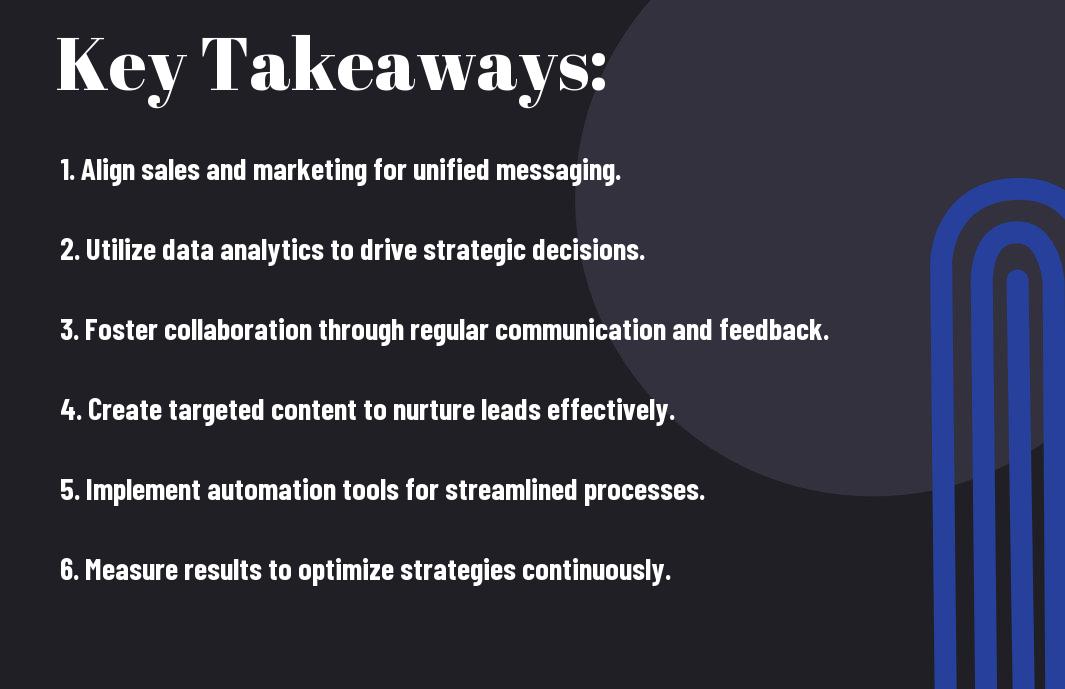With a clear understanding of the interplay between marketing and sales, you can significantly enhance your business strategy. Aligning these two departments not only streamlines communication but also amplifies your overall impact on potential customers. By implementing targeted tactics that bridge gaps and foster collaboration, you can drive higher conversion rates and increase customer loyalty. In this post, you'll discover effective strategies that can position you to make the most of every opportunity at this critical intersection.

Key Takeaways:
- Collaboration between marketing and sales teams is important for creating a unified approach that drives customer engagement and conversion.
- Data utilization is key in aligning marketing strategies with sales goals, allowing for more targeted campaigns and improved customer insights.
- Feedback loops between marketing and sales enhance strategy effectiveness by allowing teams to learn from customer interactions and refine their approaches accordingly.
Understanding the Marketing and Sales Alignment
A successful alignment between marketing and sales is necessary for achieving overall business goals. When both teams work in tandem, they can streamline processes, share valuable insights, and ultimately drive better results. You will find that by fostering communication and collaboration between these functions, your organization can create a unified strategy that not only improves efficiency but also enhances customer satisfaction and retention.
The Importance of Integration
Around 70% of companies with a strong alignment between marketing and sales report higher revenue growth. By integrating these two departments, you enable a smoother flow of information, which leads to a more cohesive customer journey. Effective integration allows you to leverage marketing data to better equip your sales team, personalize communication, and ultimately close more deals.
Common Challenges in Alignment
On the path to achieving this alignment, your teams may face several common challenges, including miscommunication, differing objectives, and disconnected technologies. These issues can hinder your overall performance and impede progress. Addressing them proactively is vital for unlocking your teams' full potential and driving revenue growth.
Integration plays a significant role in overcoming these challenges. When marketing and sales teams work in isolated silos, it often leads to a lack of understanding of each other's goals and processes. This misalignment can result in wasted efforts and inefficient resource allocation. By facilitating regular communication and utilizing shared tools, you can ensure that both teams are on the same page, ultimately creating a more harmonious and effective collaboration that boosts overall performance. Strive for alignment and watch as your business flourishes with greater synergy and impressive outcomes.

Developing a Cohesive Strategy
Assuming you want to maximize your marketing and sales impact, developing a cohesive strategy is imperative. This approach aligns both teams toward common objectives, ensuring that efforts are synchronized and that both departments operate with a unified vision. Crafting such a strategy will enhance communication, streamline processes, and ultimately drive better business results.
Shared Goals and Metrics
Across your organization, sharing goals and metrics between marketing and sales teams can significantly improve performance. By establishing joint KPIs, you foster a sense of collaboration and accountability. This alignment not only helps to measure success accurately but also drives collective efforts towards achieving shared outcomes.
Collaborative Planning Techniques
An effective approach to planning requires collaboration between marketing and sales. When you leverage collaborative planning techniques, both teams work together to brainstorm strategies, share insights, and set timelines. This empowers you to utilize the unique strengths of each team while fostering a collaborative culture that enhances overall performance.
For instance, engaging in joint brainstorming sessions enables you to tackle challenges collectively and harness the strengths of both teams. Implementing tools like shared project management software ensures that both marketing and sales are on the same page, facilitating transparency in progress. Additionally, establishing a routine for cross-departmental meetings helps you address any discrepancies or evolving strategies that need attention. Ultimately, through these collaborative techniques, you create a vibrant culture, driving both marketing and sales to achieve their maximum potential.
Leveraging Technology for Maximum Impact
Now is the time to harness technology to streamline your marketing and sales alignment. By utilizing the right tools, you can enhance communication, boost productivity, and ultimately drive better results. From CRM systems to marketing automation, every technological solution can provide valuable insights and foster stronger relationships with your customers, ensuring your strategies lead to maximum impact.
CRM Solutions and Their Benefits
Impact your sales and marketing efforts by leveraging Customer Relationship Management (CRM) solutions. These systems help you organize and analyze customer interactions, enhancing your ability to understand client needs and preferences. With features such as lead tracking and data analytics, you can optimize your targeting strategies and maintain strong customer relationships, leading to increased loyalty and conversions.
The Role of Marketing Automation
Before exploring into marketing activities, you should consider how marketing automation can transform your approach. By automating repetitive tasks, you allow your team to focus on high-impact strategies, increasing efficiency and effectiveness in your campaigns.
Solutions in marketing automation offer you personalized communication to your audience by delivering targeted messages at the right time. This technology allows you to segment your audience, automate email campaigns, and track engagement, providing valuable insights into customer behavior. With improved efficiency and the ability to nurture leads through the sales funnel, you will enhance your conversion rates and ultimately drive growth for your business, making every interaction count.
Engaging the Customer Journey
Despite the complexity of modern consumer behavior, aligning your marketing and sales efforts to engage customers throughout their journey is key. By focusing on the principles of Marketing Meets CX: A Strategy for Success, you can foster deeper connections and drive conversion rates. Effective strategies not only enhance customer satisfaction but also unite your team for a more powerful impact.
Mapping the Customer Experience
Across various touchpoints, it's crucial to map the customer experience effectively. This process enables you to identify pain points, gauge emotional responses, and optimize interactions, leading to a seamless journey that strengthens your relationship with customers.
Personalization Tactics Across Touchpoints
Journey personalization is a game changer for optimizing customer interactions. By delivering tailored content and experiences, you enhance engagement and satisfaction. Leverage data analytics to understand your audience and create dynamic marketing messages that resonate with specific needs and preferences. Personalization can occur at each stage of the customer journey, making it vital to track and analyze interactions.
Across numerous platforms and channels, personalization tactics can significantly elevate customer engagement and loyalty. You should focus on curating individualized experiences through targeted emails, personalized offers, and relevant content recommendations. By using real-time data, you can adjust strategies on the fly, ensuring prospects and customers receive the most pertinent information when they need it most. This attention to detail ultimately fosters a sense of customer connection that can drive long-term relationships and advocacy, enhancing your organization's overall performance.

Measuring Success and Continuous Improvement
Keep track of your marketing and sales strategies by consistently measuring performance. By aligning your efforts and understanding the outcomes, you can maximize impact and achieve better results. To probe deeper into this topic, you can explore 4 Key Benefits To Intersecting Strategy And Marketing.
Key Performance Indicators (KPIs)
Above all, establishing relevant Key Performance Indicators (KPIs) is imperative for evaluating the effectiveness of your marketing and sales efforts. By defining specific, measurable objectives, you can gauge your performance and identify areas for improvement, ensuring your strategies align with overall business goals.
Feedback Loops for Strategy Refinement
With feedback loops, you can continuously refine your strategies to respond to the evolving needs of your audience. Gathering insights from both your sales and marketing teams enables you to make informed adjustments and optimize your approach for maximum effectiveness.
Even small changes in your feedback loop process can lead to significant improvements in your strategy. Encouraging open communication between teams can help uncover valuable insights. Additionally, utilizing tools for collecting and analyzing results allows you to rapidly adjust based on real-time data. This iterative process fosters a culture of continuous improvement, ensuring that you stay agile and responsive to market demands while enhancing both customer satisfaction and sales performance.
Case Studies: Successful Marketing and Sales Integrations
For organizations seeking to enhance their performance, studying successful integrations of marketing and sales can provide valuable insights. Some key case studies include:
- Company A: Achieved a 30% increase in revenue by aligning marketing content with sales strategies.
- Company B: Streamlined their pipeline by reducing lead handoff times by 40%, resulting in a 25% boost in close rates.
- Company C: Garnered a 50% uplift in customer retention through a cohesive approach to customer relationship management.
Explore more in our article on Bridging the Gap: Integrating Sales and Marketing ….
Leading Companies at the Forefront
With innovative strategies, leading companies are effectively merging marketing and sales processes to drive growth. By implementing technology and analytical tools, these firms not only increase efficiency but also improve customer experience, resulting in remarkable revenue gains.
Lessons Learned from Real-world Applications
Learned from various case studies, organizations recognize that successful integration demands ongoing collaboration between marketing and sales teams. Regular communication and shared goals significantly enhance overall performance.
Further, it's crucial to keep data at the heart of your strategy. By measuring key performance indicators and openly discussing results, you can adapt strategies quickly. Companies that achieve seamless integration often note that fostering a shared culture and setting clear expectations leads to positive results. This approach not only strengthens team dynamics but also aligns your business objectives with customer needs.

Final Words
The intersection of marketing and sales offers a unique opportunity for you to maximize impact and drive growth in your business. By aligning your strategies, leveraging data insights, and fostering collaboration between teams, you can create a seamless experience for your customers. Emphasizing communication and shared objectives will help you enhance your outreach and conversions, setting you up for long-term success in an ever-evolving market landscape.
FAQ
Q: What are the main strategies to align marketing and sales for better results?
A: To align marketing and sales effectively, organizations can implement several strategies. Firstly, establishing common goals and metrics is vital, ensuring both teams are working towards the same objectives. Secondly, fostering regular communication between the two departments helps facilitate knowledge sharing and collaboration. This can be achieved through joint meetings and shared platforms for updates. Finally, utilizing technology such as Customer Relationship Management (CRM) systems can streamline processes and provide valuable insights into customer behavior, enabling both teams to strategize effectively based on real-time data.
Q: How can understanding the customer journey enhance marketing and sales efforts?
A: Understanding the customer journey aids marketing and sales teams in crafting targeted strategies at each stage of the buying process. By mapping out the journey—from awareness to consideration to decision—both teams can identify key touchpoints where they can engage with potential customers more effectively. This insight allows marketing to create content that addresses specific pain points and needs, while sales can use this information to tailor their approaches during conversations, ensuring they resonate with the customer's current situation and mindset.
Q: What role does data analytics play in optimizing marketing and sales strategies?
A: Data analytics serves a pivotal role in refining marketing and sales strategies by providing insights into customer behavior and campaign effectiveness. By analyzing patterns and trends in customer interactions, teams can better understand which initiatives yield the best results, allowing for informed decision-making. Furthermore, data can help identify potential gaps in the market or target demographics that may have been overlooked. Continuous monitoring and analysis enable marketing and sales teams to adjust their strategies in real-time, ultimately leading to improved performance and higher conversion rates.


